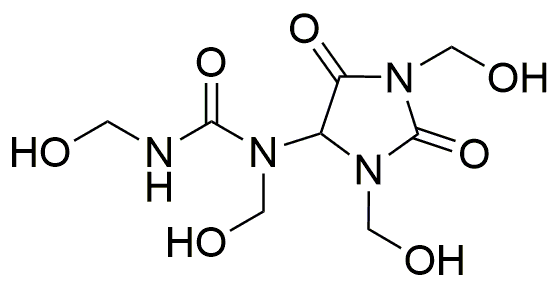Diazolidinyl urea is widely utilized in research focused on:
- Cosmetics and Personal Care: Commonly used as a preservative in lotions, creams, and shampoos, it helps extend shelf life by preventing microbial growth.
- Pharmaceuticals: Acts as a stabilizer in various formulations, ensuring the efficacy and safety of medications over time.
- Industrial Applications: Employed in the production of adhesives and coatings, enhancing product durability and performance.
- Textile Industry: Utilized in textile treatments to improve fabric resistance to bacteria and fungi, thereby increasing the lifespan of garments.
- Research Laboratories: Serves as a reagent in biochemical assays, aiding in the study of enzyme activity and protein interactions.
General Information
Properties
Safety and Regulations
Applications
Diazolidinyl urea is widely utilized in research focused on:
- Cosmetics and Personal Care: Commonly used as a preservative in lotions, creams, and shampoos, it helps extend shelf life by preventing microbial growth.
- Pharmaceuticals: Acts as a stabilizer in various formulations, ensuring the efficacy and safety of medications over time.
- Industrial Applications: Employed in the production of adhesives and coatings, enhancing product durability and performance.
- Textile Industry: Utilized in textile treatments to improve fabric resistance to bacteria and fungi, thereby increasing the lifespan of garments.
- Research Laboratories: Serves as a reagent in biochemical assays, aiding in the study of enzyme activity and protein interactions.
Documents
Safety Data Sheets (SDS)
The SDS provides comprehensive safety information on handling, storage, and disposal of the product.
Product Specification (PS)
The PS provides a comprehensive breakdown of the product’s properties, including chemical composition, physical state, purity, and storage requirements. It also details acceptable quality ranges and the product's intended applications.
Certificates of Analysis (COA)
Search for Certificates of Analysis (COA) by entering the products Lot Number. Lot and Batch Numbers can be found on a product’s label following the words ‘Lot’ or ‘Batch’.
*Catalog Number
*Lot Number
Certificates Of Origin (COO)
This COO confirms the country where the product was manufactured, and also details the materials and components used in it and whether it is derived from natural, synthetic, or other specific sources. This certificate may be required for customs, trade, and regulatory compliance.
*Catalog Number
*Lot Number
Safety Data Sheets (SDS)
The SDS provides comprehensive safety information on handling, storage, and disposal of the product.
DownloadProduct Specification (PS)
The PS provides a comprehensive breakdown of the product’s properties, including chemical composition, physical state, purity, and storage requirements. It also details acceptable quality ranges and the product's intended applications.
DownloadCertificates of Analysis (COA)
Search for Certificates of Analysis (COA) by entering the products Lot Number. Lot and Batch Numbers can be found on a product’s label following the words ‘Lot’ or ‘Batch’.
*Catalog Number
*Lot Number
Certificates Of Origin (COO)
This COO confirms the country where the product was manufactured, and also details the materials and components used in it and whether it is derived from natural, synthetic, or other specific sources. This certificate may be required for customs, trade, and regulatory compliance.


